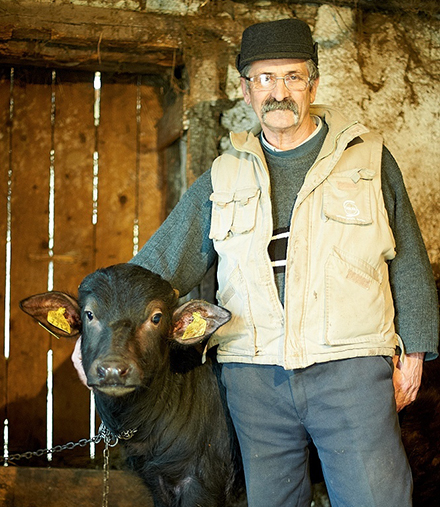Water buffalo have been raised in Romania’s Transylvanian and Banat regions since their introduction by the Turks during the 15thcentury Ottoman invasion. Today, there are three types of Romanian water buffalo: Danubian; Indian Murrah, developed through intensive cross breeding with Murrah stock from Bulgaria; and Carpathian, known as having the best genetics and the best adapted to cold climates.

In 1929 there were more than 187,000 head of water buffalo in Romania. That number rose to more than 228,000 in 1980. During Communism, Romanian buffalo were replaced with dairy animals–a trend that continued after the fall of Communism in 1989. Today, with only 15,000 head of water buffalo in Romania, the breed is dangerously close to extinction.
Heifer Romania developed the Revitalization of Water Buffalo Project to improve income generation and nutrition for families, help save this species, as well as to offer a livestock alternative to the strict EU standards that limit the sale of cow’s milk. In 2010, 39 water buffalo were placed with families in the Hungarian village of Mera and the Romanian village of Aschileu. Participants received valuable training, and a foundation of peace and understanding was built between these cultural groups. Many original project participants have fulfilled their Passing on the Gift® commitment and, so far, 61 families have received water buffalo.
Give the gift of water buffalo and watch a family prosper.
Once very popular in Mera and Aschileu, water buffalo are once again catching the attention of families here, who are interested in dairy products, especially mozzarella and feta cheese. While the animal’s rich milk contains an abundance of butterfat and protein, it is very low in cholesterol. Other gifts from the buffalo include manure, draft power, and meat, which has a nice, sweet flavor and is low in cholesterol.
Water buffalo empower farmers to make significant financial and nutritional improvements for their families. They can live on simple fodder, such as wet pasture, straw and dry corn stems. Stronger than other species, the water buffalo is highly resistant to disease and even immune to many common cattle illnesses. Interestingly, they are powerful swimmers.
On most small farms, water buffalo stay in enclosed barns during the winter and enjoy a combination of stable housing and grazing in warmer seasons. It’s easy to keep both water buffalo and cattle because they coexist peacefully.
Heifer Romania always encourages small farmers to consider breeding water buffalo. “The benefits would be many,” says George Abrudan, field assistant. “Animals are resilient. They are not picky eaters, and the milk, even though it is fat, has a low cholesterol level.”
Farkas Doroghi, president of the Bovine Breeders Association in Aschileu, agrees. “For now, in our country, there are no buffalo milk processors. Nor is the Romanian consumer is very familiar with buffalo milk. Abroad, however, the demand for buffalo milk is very high. We have even had buffalo purchase requests from Norway, Italy and France.”
Basically, they restock their areas with the Romanian buffalo breed, and in Romania the species is at risk. For more than 1,500 years the buffalo has been bred on Romanian land. Through the Revitalization of Water Buffalo Project, Heifer Romania is working to bring their numbers back up and, therefore, improve life for families in this region.
Story by Laura Manciu
Communication and PR Coordinator
Heifer Romania
Photos courtesy of Heifer Romania